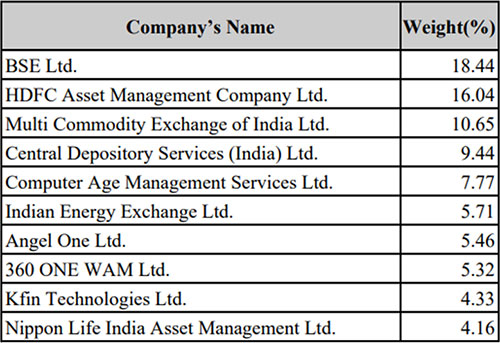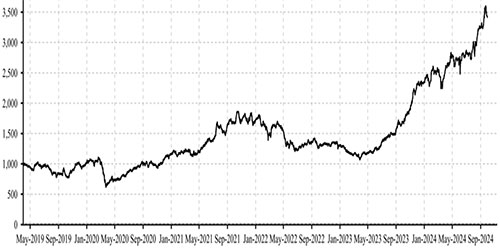Publish Date:
The National Stock Exchange (NSE) recently, on September 9, 2024, launched the Nifty Capital Markets Index. This index aims to track the performance of stocks from the Nifty 500 index which represents the capital markets theme.
Ascertaining the upbeat sentiments in the Indian equity markets, Tata Mutual Fund has now launched the Tata Nifty Capital Markets Index Fund, which is the country's first index fund that shall invest in companies that are part of the Nifty Capital Markets Index.
It is an open-ended scheme replicating/tracking the Nifty Capital Markets Index - Total Return Index (TRI).
To put it simply, the Scheme will invest in equity securities covered by the Nifty Capital Markets Index with a passive style of fund management. Thus, the returns of the Scheme would commensurate (before fees and expenses) with the performance of the underlying benchmark index, subject to a tracking error.
During the NFO period, the Scheme is open for subscription from October 7, 2024, to October 21, 2024. Thereafter the Scheme will re-open for continuous sale and repurchase on October 31, 2024.
The Tata Nifty Capital Markets Index Fund under normal circumstances would invest 95% to 100% of the total net assets in the securities covered by the Nifty Capital Markets Index. The scheme will invest in all the stocks in the same weightage that they represent in the underlying Index.
The Scheme may also take exposure to equity derivatives instruments of constituents of the underlying index for a short duration when securities of the index are unavailable, insufficient or for rebalancing at the time of change in the index or in case of corporate actions, as permitted. The margin money requirement for derivative exposure will be held in the form of Term Deposits, cash or cash equivalents or as may be allowed under the Regulations.
Up to 5% of the total net assets of the Scheme will be invested in debt & money market instruments, including units of mutual funds.
Debt & money market instruments include instruments like but not limited to Commercial Paper (CP), Certificates of Deposit (CD), Treasury bills (T-bills), Bills Rediscounting (BR), short-term corporate bonds, repos, short-term Government securities (G-secs) and any other such short-term instruments as may be allowed under the regulations prevailing from time to time.
A part of the net assets may be invested in the triparty repo as may be permitted by RBI to meet the liquidity requirements. Securities in which investment is made for the purpose of ensuring liquidity (debt and money market instruments) are those that fall within the definition of liquid assets.
The scheme may also invest in units of liquid/money market/debt mutual fund schemes of Tata Mutual Fund or in the Scheme(s) of other mutual funds in conformity with the investment objective/ asset allocation of the Scheme.
The Tata Nifty Capital Markets Index Fund will not invest in the following:
-
Securitised debt
-
AT1 and AT2 bonds
-
Credit Default Swaps (CDS)
-
Repo in corporate debt securities and corporate reverse repo
-
Debt instruments having Structured Obligations (SO) or Credit Enhancements (CE)
-
Unrated debt instruments
-
Overseas securities
-
And will not engage in short selling of securities
What Is the Investment Objective?
The investment objective of the scheme is to provide returns, before expenses, that commensurate with the performance of the Nifty Capital Markets Index (TRI), subject to tracking error.
However, there is no assurance or guarantee that the investment objective of the scheme will be achieved. The scheme does not assure or guarantee any returns.
What Is the Investment Strategy?
The Tata Nifty Capital Markets Index Fund being passively managed will employ an investment approach designed to replicate/track the performance of the Nifty Capital Markets Index (TRI).
The Scheme seeks to achieve this goal by investing in securities constituting the Index in the same proportion as in the Index. The Scheme will invest at least 95% of its total assets in the securities comprising the underlying index.
The tracking error could occur due to a variety of factors but not limited to:
-
Delay in the purchase or sale of stocks within the benchmark due to: i) Illiquidity in the stock, and ii.) Delay in realization of sale proceeds
-
The scheme may buy or sell the stocks comprising the index at different points of time during the trading session at the then prevailing prices which may not correspond to its closing prices
-
The potential for trades to fail, which may result in the Scheme not having acquired the stocks at a price necessary to track the benchmark price
-
The holding of a cash position and accrued income prior to distribution of income and payment of accrued expenses.
-
Investment in debt and money market instruments to meet redemption / other liquidity requirements
-
Addition or Removal of stocks from the index-by-index service provider
-
Disinvestments to meet redemptions, recurring expenses, income distribution cum capital withdrawal payouts etc.
-
Execution of large buy/sell orders.
-
Transaction cost and recurring expenses
-
Delay in realization of Unit holders' funds
-
Levy of margins by exchanges
That said, the Scheme will endeavour to minimize the tracking error by:
-
Rebalancing of the portfolio
-
Setting off incremental subscriptions against redemptions
-
Use of derivatives for portfolio rebalancing and efficient portfolio management
-
Fast track in expediting in deployment of cash
-
Maintaining low levels of cash
The AMC would monitor the tracking error of the Scheme on an ongoing basis and would seek to minimize tracking error to the maximum extent possible. The tracking error based on the past one year's rolling data shall not exceed 2%.
However, in case of events like dividend issuance by constituent members, rights issuance by constituent members, and market volatility during rebalancing of the portfolio following the rebalancing of the Underlying Basket, etc. or in abnormal market circumstances, which are beyond the control of the AMCs, the tracking error may exceed 2%. However, the Fund will endeavour to limit the tracking error within 2% limits.
The Scheme will benchmark its performance against the Nifty Capital Markets Index (TRI).
About the Nifty Capital Markets Index
As mentioned before, the Nifty Capital Markets Index was launched by the NSE on September 9, 2024 (with April 1, 2019, as the base date).
This index aims to track the performance of stocks from the Nifty 500 Index which represents the capital markets theme. The largest 20 stocks from eligible basic industries are selected based on a 6-month average free-float market capitalisation, and this is reconstituted semi-annually and rebalanced quarterly.
Currently, the Nifty Capital Markets Index comprises 20 stocks and the stock weights are capped at 20%.
At present, the top constituents of this index are as under:
Table 1: Top Constituents of the Nifty Capital Markets Index

(Source: NSE Indexogram Factsheet as of September 2024)
Given that this index is called the Nifty Capital Markets Index, it has representation only to the financial services sector, which is the overall growth of India.
Since the base date of April 1, 2019, the Nifty Capital Markets Index has clocked a price return of 25.0% CAGR and a total return (which includes dividends) of 26.9% (as of September 30, 2024).
Graph 1: Long-term Performance of Nifty Capital Markets Index

(Source: NSE Indexogram Factsheet as of September 2024)
As seen in Graph 1, particularly since the lows of the COVID-19 pandemic, the Nifty Capital Markets Index representing the financial services sector has performed exceptionally well - generating handsome returns for investors.
Over the last one year, the Nifty Capital Markets Index has clocked a stunning absolute total return of 104.8% as of September 30, 2024, rewarding investors very well.
Here's what Mr Anand Vardarajan, Chief Business Officer of Tata Mutual Fund said in a press release on the launch of the fund:
"India's capital markets have been on a remarkable growth trajectory over the past few years. We have seen a massive surge of growth in demat accounts which now stands close to 16 crore. The mutual fund industry's AUM surpassed the Rs.65 lakh crore mark in August 2024. That having said, India's MF AUM-to-GDP ratio stands at just 16%, well below the global average of 74%, highlighting significant potential for future growth. The growing population and rising income level is also leading to a surge in HNI investors which are being catered by broking and wealth management outfits to meet their investment needs. This has led to the growth of the entire capital market ecosystem comprising broking, depository, exchanges, RTAs and so on."
Who Will Manage Tata Nifty Capital Markets Index Fund?
Mr Kapil Menon will manage the Scheme.
Kapil is a commerce graduate (B.Com) has a collective work experience of 20 years and is a seasoned investment professional. Kapil joined Tata Asset Management in 2006, starting his journey in the investment team.
Demonstrating his expertise and versatility, he was entrusted with the additional responsibilities of an Equity Dealer in 2021.
Further from April 2024, he was assigned the role of Fund Manager for Index Funds. Before his tenure at Tata Asset Management, Mr. Kapil worked at CRISIL Ltd, where he contributed to the Financial Sector Ratings team.
At Tata Mutual Fund, Kapil manages various passively managed index funds and exchange-traded funds.
How Much is the Minimum Investment in Tata Nifty Capital Markets Index Fund?
During the NFO period, i.e. from October 7, 2024, to October 21, 2024, the minimum investment in the Scheme is Rs 5,000/- and multiple of Re 1/- thereafter. In the case of SIP, the minimum instalment amount is RS 150/-.
In case you are an existing investor with Tata Mutual Fund, there is no minimum amount requirement for opting to switch "all units" from any existing schemes of Tata Mutual Fund to this Scheme.
The Scheme offers both, the Direct Plan and Regular Plan for investment and each Plan offers the Growth Option and the Income Distribution cum Capital Withdrawal Option (IDCW) for investing.
[Read: IDCW vs Growth Option: Which One Should You Opt for]
Who Should Consider Investing in Tata Nifty Capital Markets Index Fund?
The fund is suitable for those investors who are looking for long capital appreciation with a passively managed fund investing in a portfolio of companies forming part of the Nifty Capital Markets Index.
That being said, keep in mind that the Nifty Capital Markets Index has representation only to the financial services sector, and while it stands as a proxy to India's economic growth, you would be exposed to high sector concentration risk. On the risk-o-meter, the Tata Nifty Capital Markets Index Fund is positioned as a very high-risk fund.
Considering the current valuations, even if you have a very high-risk appetite, do note that the fortune of the Scheme will be closely linked to the performance of the Nifty Capital Markets Index.
To know more about the Tata Nifty Capital Markets Index Fund, read the Scheme Information Document and Key Information Memorandum.
Make an informed investment decision and be a thoughtful investor.
Happy Investing!